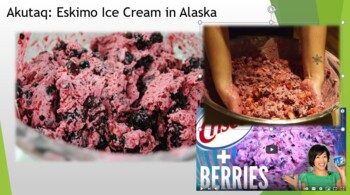Akutaq: Berry Ice Cream Calorimetry Lab
111 Downloads
3D-PT
125 Followers
Grade Levels
7th - 12th, Higher Education, Adult Education, Homeschool, Staff
Subjects
Resource Type
Standards
CCSSRI.6.5
CCSSRI.6.9
CCSSRH.6-8.3
CCSSRH.6-8.5
CCSSRH.6-8.7
Formats Included
- PDF
- Easel Activity
Pages
25 pages
FREE
3D-PT
125 Followers
Easel Activity Included
This resource includes a ready-to-use interactive activity students can complete on any device. Easel by TPT is free to use! Learn more.
Also included in
- Are you looking for a bundle of affordable STEM labs for your science class? This bundle has 38 files worth of field tested labs. All include materials list, worksheets, and field pictures! You can cover earth science, chemistry, biology as well as other topics with this package. The bundles coverPrice $107.28Original Price $153.25Save $45.97
- Chemistry is taught as a 2D flat part of the periodic table, but in truth it's 3D and interactive! This bundle is a whole semesters worth of chemistry!It includes 3D printable labs, class sized periodic tables, and hands-on labs for real learning!A full bundle here is at a 10% discount from full priPrice $49.73Original Price $60.50Save $10.77
Description
Explore the rich cultural heritage of the Central Yupik people of AK while engaging your students in a captivating scientific journey with our "Akutaq Berry Ice Cream Calorimetry Lab." This unique laboratory activity not only delves into the world of calorimetry but also celebrates the indigenous knowledge and traditions of the Central Yupik community.
Key highlights of the "Akutaq Berry Ice Cream Calorimetry Lab" include:
- Indigenous Wisdom: Immerse your students in the centuries-old traditions of the Central Yupik people. Explore the significance of akutaq, a traditional Yupik dish made with berries and seal oil, and the valuable knowledge passed down through generations.
- Hands-On Learning: This lab provides a hands-on opportunity for students to create akutaq berry ice cream while exploring concepts of calorimetry. They'll learn about energy transfer and heat exchange in a fun and culturally immersive context.
- Cultural Connection: Discuss the importance of food in indigenous cultures, emphasizing how it reflects a community's history, environment, and values. Explore the role of akutaq in Central Yupik gatherings and celebrations.
- Ingredient Exploration: Dive into the science of food chemistry by studying the properties of the ingredients used in akutaq (Eskimo ice cream). Analyze the impact of berries and other components on the final product.
- Calorimetry Investigations: Engage students in calorimetry experiments, measuring and analyzing the energy changes that occur during the freezing process. Connect these findings to the concept of heat transfer in the context of traditional food preparation.
- Interdisciplinary Learning: Seamlessly integrate cultural studies, science, and history in a single activity. Explore the relationship between indigenous knowledge, climate, and food preservation.
- Respect and Appreciation: Promote cultural sensitivity, understanding, and respect among students as they learn about the Central Yupik people and their heritage.
- Culinary Creativity: Encourage students to experiment with flavors and ingredients, allowing them to personalize their akutaq berry ice cream while respecting the essence of the traditional dish.
Total Pages
25 pages
Answer Key
N/A
Teaching Duration
N/A
Report this resource to TPT
Reported resources will be reviewed by our team. Report this resource to let us know if this resource violates TPT’s content guidelines.
Standards
to see state-specific standards (only available in the US).
CCSSRI.6.5
Analyze how a particular sentence, paragraph, chapter, or section fits into the overall structure of a text and contributes to the development of the ideas.
CCSSRI.6.9
Compare and contrast one author’s presentation of events with that of another (e.g., a memoir written by and a biography on the same person).
CCSSRH.6-8.3
Identify key steps in a text’s description of a process related to history/social studies (e.g., how a bill becomes law, how interest rates are raised or lowered).
CCSSRH.6-8.5
Describe how a text presents information (e.g., sequentially, comparatively, causally).
CCSSRH.6-8.7
Integrate visual information (e.g., in charts, graphs, photographs, videos, or maps) with other information in print and digital texts.








